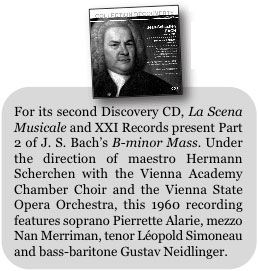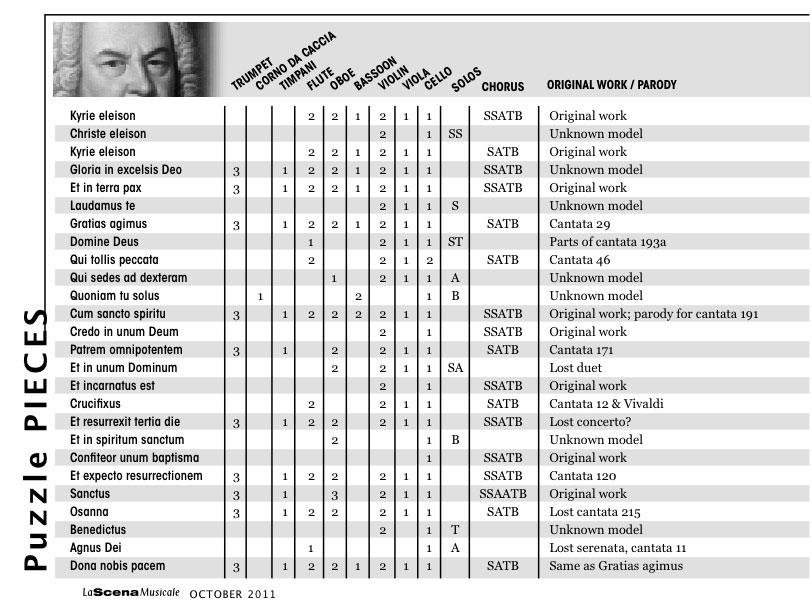Discovery CD: Bach’s Mass in B-Minor is a Timeless Musical Monument by Alexandra Amati-Camperi, Ph.D
/ October 1, 2011
Version française...
Flash version here.
 J. S. Bach (Eisenach
1685–Leipzig 1750) never wrote a mass in B minor. Though this statement
may surprise, it is, strictly speaking, correct. This piece is not what
was intended by the word missa (“mass”) in Lutheran Germany
(usually comprising only the Kyrie and Gloria) and it is not in B minor.
Though it does start in that key, a rare and difficult key at the time,
the main key is D major. The “Mass in B Minor” is actually a later
compilation of separate parts of the Latin mass (technically called
a missa tota) that Bach had mostly composed previously over a
period of decades. The name by which it is known, “Mass in B Minor,”
was attached to the composition in 1845 by its first publisher, Hermann
Nägeli, undoubtedly making a connection with Beethoven’s Missa
solemnis. J. S. Bach (Eisenach
1685–Leipzig 1750) never wrote a mass in B minor. Though this statement
may surprise, it is, strictly speaking, correct. This piece is not what
was intended by the word missa (“mass”) in Lutheran Germany
(usually comprising only the Kyrie and Gloria) and it is not in B minor.
Though it does start in that key, a rare and difficult key at the time,
the main key is D major. The “Mass in B Minor” is actually a later
compilation of separate parts of the Latin mass (technically called
a missa tota) that Bach had mostly composed previously over a
period of decades. The name by which it is known, “Mass in B Minor,”
was attached to the composition in 1845 by its first publisher, Hermann
Nägeli, undoubtedly making a connection with Beethoven’s Missa
solemnis.
Towards the end
of his life, the great Leipzig chapel master apparently felt an urge
towards completeness, towards writing pieces that explored and exhausted
all the possibilities of a certain compositional technique or style.
This desire resulted in some of the greatest compositions of all time,
such as the unfinished Art of the Fugue (an exploration of all
possible contrapuntal uses of a single theme or subject, started first
in 1740 and restarted in 1747), the Clavier-Übung IV, known
since the 19th century as the “Goldberg Variations” (a compendium
of all possible ways of varying a single theme, 1747), the Musical
Offering (also from 1747, an exhaustive exploration of all that
could be done with a single musical idea, the ‘royal’ theme written
by Frederick the Great of Prussia and used in two ricercares for keyboard
in three and six parts; a trio sonata for flute, violin and continuo;
and various canons for flute, violin and continuo with harpsichord obbligato),
and the variations on “Vom Himmel hoch” (1747), besides the Mass
in B Minor (1748–49).
In 1954, the eminent
Bach scholar Friedrich Smend edited the mass and showed that it had
originated from different parts of Bach’s life. The full autograph
score had been compiled in 1748–1749, and its original intended use
is unknown. Helmuth Osthoff has suggested that Bach may have compiled
it for the dedication of the chapel of the Dresden court (for which
the Kyrie and Gloria—the Missa—had been composed in 1733),
which was scheduled to be completed in 1748 but was not completed until
1751, one year after Bach’s death. There is no evidence that the mass
was ever performed during Bach’s lifetime.
What we usually
intend by the word “mass” is a setting of the ordinary of
the mass, that is, of those parts of the liturgy that remain the same
throughout the year, regardless of the feast day. The feast-specific
parts are known as the proper of the mass, and they change every
day of the year. The ordinary of the mass, sung every day in Catholic
churches, consists of five parts: Kyrie, Gloria, Credo, Sanctus (which
includes also the Benedictus framed by two repetitions of the Osanna),
and Agnus Dei. In the Lutheran tradition, a missa is a setting
of just the Kyrie and Gloria, which together are called “mass” because
they are the only two parts of the ordinary that are sung at Sunday
service. In 1724, the second year of his tenure in Leipzig, Bach composed
a six-voice Sanctus for the Christmas service (because the Sanctus,
without Benedictus or Osanna, is sung only on high feasts in the Lutheran
church). Then, in 1733, he wrote a Missa for the Catholic Dresden
court, as part of his application for the post of court composer. It
was probably around 1747 that he composed the most magnificent, majestic,
and architecturally and stylistically perfect section—the Credo, or
Symbolum nicenum (Nicene Creed). Finally, when he compiled all of
the music into a full score, he added the last movements of the ordinary
(Osanna, Benedictus, Agnus Dei, and Dona nobis pacem), adapting music
he had previously written in a widespread Baroque technique known as
“parody,” whereby a composer adapts and partially rewrites existing
music to a new text.
In fact, most of
the mass is a “parody”—according to present knowledge; only eight
out of the mass’s 25 movements can be considered with certainty to
be original compositions, though the models for only seven of the remaining
17 movements have been identified. Based on a study of both the manuscript
sources and of Bach’s compositional techniques and style, scholars
have postulated that those movements without identifiable models were
probably based on pieces that have been lost.
The table below
lists all the movements, the performing forces, both instrumental and
vocal, and the models from which the mass movements were “parodied,”
extant or unknown.

The critical edition
of the works of J. S. Bach—the Neue Bach-Ausgabe
or NBA—was begun in 1954, with the purpose of publishing all of Bach’s
works according to the latest scholarship, going back to the original
sources and marking all corrections, emendations, and suggestions in
fonts clearly distinct from original markings, as well as providing
a critical apparatus. The B Minor Mass was one of the earliest
volumes in the NBA (No. 2, 1954, edited by F. Smend) and is now over
50 years old. Since then, discoveries and technological advances have
made that venerable volume in many respects obsolete. Late in 2010,
the Neue Bach-Ausgabe Revised Edition
(which took over from the NBA once its original mission was completed)
published a revised score of the Mass, taking into consideration all
sources available, including the “Dresden parts” (the 1733 orchestral
parts of the Kyrie and Gloria) and the autographs. This new score also
marks the distinction between the original J. S. Bach version and the
additions and changes by his son C. P. E. Bach. These were not distinguishable
before since the hands are nearly identical, but can now be told apart
thanks to x-ray fluorescence analysis of the ink.
The B Minor
Mass, with its broad palette of styles and sonorities, offers new
discoveries, surprises and endless riches to the dedicated student or
attentive listener even after years of performance or study. In all
choral literature, there is no work that can be at once as satisfying,
encyclopedic, pleasing, challenging, complex, and rewarding as the
B Minor Mass for both performers and listeners alike—a masterpiece
indeed, that may be enjoyed by all.
Alexandra Amati-Camperi,
originally from Italy, holds a BA/MA in Slavic Studies and Philology
from the Università degli Studi di Pisa (Italy), degrees in piano
from the Conservatory of Music of Lucca (Italy), and both an MA and
a Ph.D. in Musicology from Harvard University. She is presently Department
Chair and Professor of Music at the University of San Francisco.
Version française... |
|


